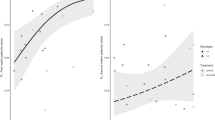Summary
Under laboratory conditions, female guppies demonstrate a clear preference for males with larger tails, and this preference translates into enhanced reproductive fitness for these males. Females also prefer males with higher display rates, a behavior which appears to be linked to tail size, but which can be experimentally disassociated. This appears to be a case of female-choice sexual selection.
Similar content being viewed by others
References
Andersson M (1982) Female choice selects for extreme tail length in the widow-bird. Nature 299:818–820
Brown L (1981) Patterns of female choice in mottled sculpins (Cottidae, Teleostel). Anim Behav 29:375–382
Croy M Le (1981) The genus Paradisaea — display and evolution. Am Mus Novit 2714:1–52
Darwin C (1871) The descent of man, and selection in relation to sex. Murray, London
Davies NB, Halliday TR (1977) Optimal mate selection in the toad Bufo bufo. Nature 269:56–58
Davidson GWH (1981) Sexual selection and mating systems of Argusianus argus (Aves: phasianidae). Biol J Linn Soc 15:91–104
Endler JA (1978) A predator's view of animal color patterns. Evol Biol 11:319–364
Endler JA (1983) Natural and sexual selection on color patterns in poeciliid fishes. Environ Biol Fishes 9:173–190
Fairchild L (1981) Mate selection and behavioural thermoregulation in Fowler's toads. Science 212:950–951
Farr JA (1980) Social behavior patterns as determinants of reproductive success in the guppy, Poecilia reticulata Peters (Pisces: Poecillidae) — an experimental study of the effects of intermale competition, female choice and sexual selection. Behaviour 74:38–91
Halliday TR (1978) The newt as an honest salesman. Anim Behav 26:1273–1274
Parker GA (1982) Phenotype-limited evolutionary-stable strategies. In: King's College Sociobiology Group (ed) current problems in sociobiology. Cambridge University Press, Cambridge, pp 169–173
Petrie M (1983) Female moorhens compete for small fat males. Science 220:413–415
Rhijn JG van (1973) Behavioural dimorphism in male ruffs, Philomachus pugnax (L.). Behaviour 47:153–229
Ridley M (1981) How the peacock got his tail. New Sci 91:398–401
Rubenstein DI (1981a) Individual variation and competition in the Everglades pygmy sunfish. J Anim Ecol 50:337–350
Rubenstein DI (1981b) Population density, resource patterning and territoriality in the Everglades pygmy sunfish. Anim Behav 29:155–172
Smith LM (1965) Changes in the tail feathers of adolescent lyrebird. Science 147:510–513
Author information
Authors and Affiliations
Rights and permissions
About this article
Cite this article
Bischoff, R.J., Gould, J.L. & Rubenstein, D.I. Tail size and female choice in the guppy (Poecilia reticulata). Behav Ecol Sociobiol 17, 253–255 (1985). https://doi.org/10.1007/BF00300143
Received:
Accepted:
Issue Date:
DOI: https://doi.org/10.1007/BF00300143




